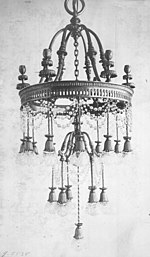The year 1908 in architecture involved some significant architectural events and new buildings.

Astor Row is the name given to 28 row houses on the south side of West 130th Street, between Fifth and Lenox Avenues in the Harlem neighborhood of Manhattan, New York City, which were among the first speculative townhouses built in the area. Designed by Charles Buek, the houses were built between 1880 and 1883 in three spurts, on land John Jacob Astor had purchased in 1844 for $10,000. Astor's grandson, William Backhouse Astor, Jr., was the driving force behind the development.

The Union Club of the City of New York is a private social club in New York City that was founded in 1836. The clubhouse is located at 101 East 69th Street on the corner of Park Avenue, in a landmark building designed by Delano & Aldrich that opened on August 28, 1933.

The Robb House, located at 23 Park Avenue on the corner of East 35th Street in the Murray Hill neighborhood of Manhattan, New York City is a townhouse built in 1888-92 and designed in the Italian Renaissance revival style by McKim, Mead & White, with Stanford White as the partner-in-charge.
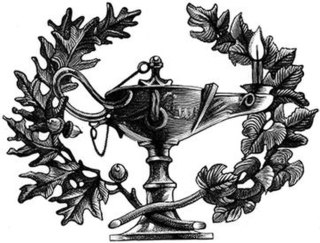
The Century Association is a private social, arts, and dining club in New York City, founded in 1847. Its clubhouse is located at 7 West 43rd Street near Fifth Avenue in Midtown Manhattan. It is primarily a club for men and women with distinction in literature or the arts. The Century Association was founded by members of New York's Sketch Club; preceding clubs also included the National Academy of Design, the Bread and Cheese Club, and the Column. Traditionally a men's club, women first became active in club life in the early 1900s; the organization began admitting women as members in 1988.
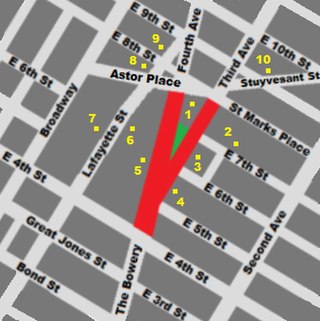
Cooper Square is a junction of streets in Lower Manhattan in New York City located at the confluence of the neighborhoods of Bowery to the south, NoHo to the west and southwest, Greenwich Village to the west and northwest, the East Village to the north and east, and the Lower East Side to the southeast.
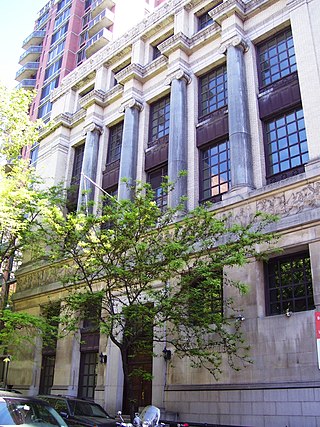
The New York School of Applied Design for Women, established in 1892 by Ellen Dunlap Hopkins, was an early design school for women in New York City. The 1908 New York School of Applied Design building was designed by Harvey Wiley Corbett and is now landmarked.

The De Vinne Press Building, located at 393-399 Lafayette Street at the corner of East 4th Street, in the NoHo district of lower Manhattan, New York City, is a brick structure, built in 1885-1886 and designed by the firm of Babb, Cook & Willard in Romanesque Revival style. An addition was made to the building in 1892.

The Montauk Club is a social club located in a Francis Kimball-designed building in Park Slope, Brooklyn. The Club provides dining and drinking services and offers an extensive schedule of events including a Book Club, a Beer Club, Murder Mystery Dinners, and is a sought-after wedding and event venue. Members also have privileges at 66 reciprocal clubs, located in 33 states and the District of Columbia and six countries, including Canada, England, India, Ireland, Netherlands and Philippines.
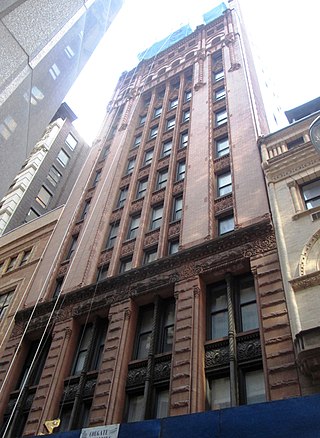
56 Pine Street – originally known as the Wallace Building after its developer, James Wallace – at 56-58 Pine Street between Pearl and William Streets in the Financial District of Manhattan, New York City, was built in 1893-94 and was designed by Oscar Wirz in the Romanesque Revival style.

The Sherry-Netherland is a 38-story apartment hotel located at 781 Fifth Avenue on the corner of East 59th Street in the Upper East Side neighborhood of Manhattan in New York City. It was designed Schultze & Weaver with Buchman & Kahn. The building is 560 ft (170.7 m) high and was the tallest apartment-hotel in New York City when it opened.

The Joseph Raphael De Lamar House is a mansion at 233 Madison Avenue at the corner of 37th Street in the Murray Hill neighborhood of Manhattan, New York City. The house, currently the Consulate General of Poland, New York City, was built in 1902–1905 and was designed by C. P. H. Gilbert in the Beaux-Arts style. The De Lamar Mansion marked a stark departure from Gilbert's traditional style of French Gothic architecture and was instead robustly Beaux-Arts, heavy with rusticated stonework, balconies, and a colossal mansard roof. The mansion is the largest in Murray Hill, and one of the most spectacular in the city; the interiors are as lavish as the exterior.
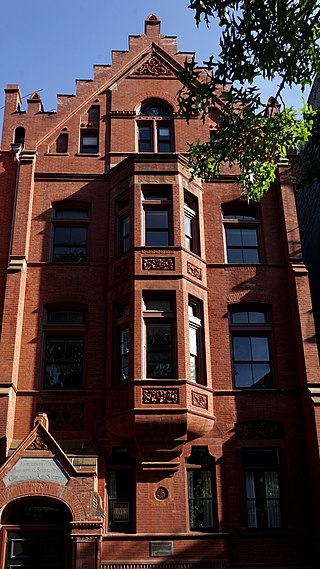
The Fourteenth Ward Industrial School is located at 256-258 Mott Street between Prince and Houston Streets in the Nolita neighborhood of Manhattan, New York City. It was built for the Children's Aid Society in 1888–89, with funds provided by John Jacob Astor III, and was designed by the firm of Vaux & Radford in the Victorian Gothic style. The Society built a number of schools for indigent children at the time. It was later known as the Astor Memorial School.
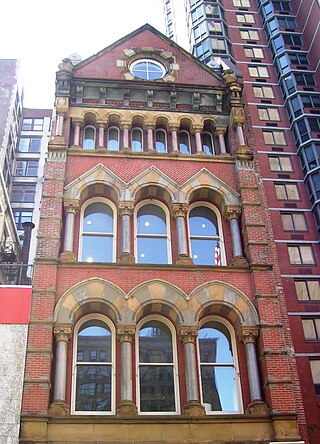
The David S. Brown Store at 8 Thomas Street between Broadway and Church Street in the TriBeCa neighborhood of Manhattan, New York City was built in 1875-76 for a soap manufacturer. It was designed by J. Morgan Slade in the Victorian Gothic style, as influenced by John Ruskin and French architectural theory. The building has been called "An elaborate confection of Romanesque, Venetian Gothic, brick, sandstone, granite, and cast-iron parts..."
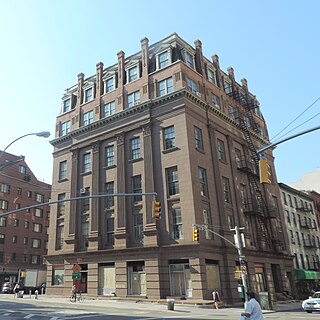
The Odd Fellows Hall is a building at 165–171 Grand Street between Centre and Baxter Streets, in the Little Italy and SoHo neighborhoods of Manhattan, New York City. It was built in 1847–1848 and designed by the firm of Trench & Snook in the Italianate style, one of the city's earliest structures in this style, which Joseph Trench had brought to New York with his design for 280 Broadway in 1845. His partner, John B. Snook, was responsible for many cast-iron buildings in SoHo. The mansard roof was an addition, designed by John Buckingham and built in 1881–1882. The Independent Order of Odd Fellows used the building until the 1880s, when they moved uptown with the city's population. The building was afterwards converted for commercial and industrial use.

Scheffel Hall at 190 Third Avenue in the Gramercy Park neighborhood of Manhattan, New York City, was built in 1894–1895, and designed by Henry Adams Weber and Hubert Drosser, at a time when the area south of it was known as Kleindeutschland due to the large number of German immigrants who lived nearby. The building, which served as a beer hall and restaurant, was modeled after an early 17th-century building in Heidelberg Castle, the "Friedrichsbau", and was named after Joseph Viktor von Scheffel, a German poet and novelist. It later became known as Allaire's, a name still inscribed on the building. The building's style has been described as "German-American eclectic Renaissance Revival".

Gilsey House is a former eight-story 300-room hotel located at 1200 Broadway at West 29th Street in the NoMad neighborhood of Manhattan, New York City. It is a New York City landmark and on the National Register of Historic Places.

The St. Aloysius Catholic Church is a Catholic parish in the Archdiocese of New York, located at 209-217 West 132nd Street between Adam Clayton Powell Jr. Boulevard and Frederick Douglass Boulevard in the Harlem neighborhood of Manhattan, New York City.

The East 17th Street/Irving Place Historic District is a small historic district located primarily on East 17th Street between Union Square East and Irving Place in the Union Square neighborhood of Manhattan, New York City. It was designated by the New York City Landmarks Preservation Commission on June 30, 1988, and encompasses nine mid-19th century rowhouses and apartment buildings on the south side of East 17th Street, from number 104 to number 122, plus one additional building at 47 Irving Place just south of 17th Street.

175 West Broadway is a building between Worth and Leonard Streets in the Tribeca neighborhood of Manhattan, New York City. Built in 1877, it was designed by Scott & Umbach, an architectural firm from Newark, New Jersey, in the polychromatic brick style. According to the New York City Landmarks Preservation Commission, the building's "corbeled window arches and the corbeled brick cornice are without parallel in New York City architecture." It was built as a rental property for the heirs of Jerome B. King, a notable manufacturer of plaster and cement products, and was occupied for many years by Harwood & Son, who manufactured and sold awnings and other products made from canvas


